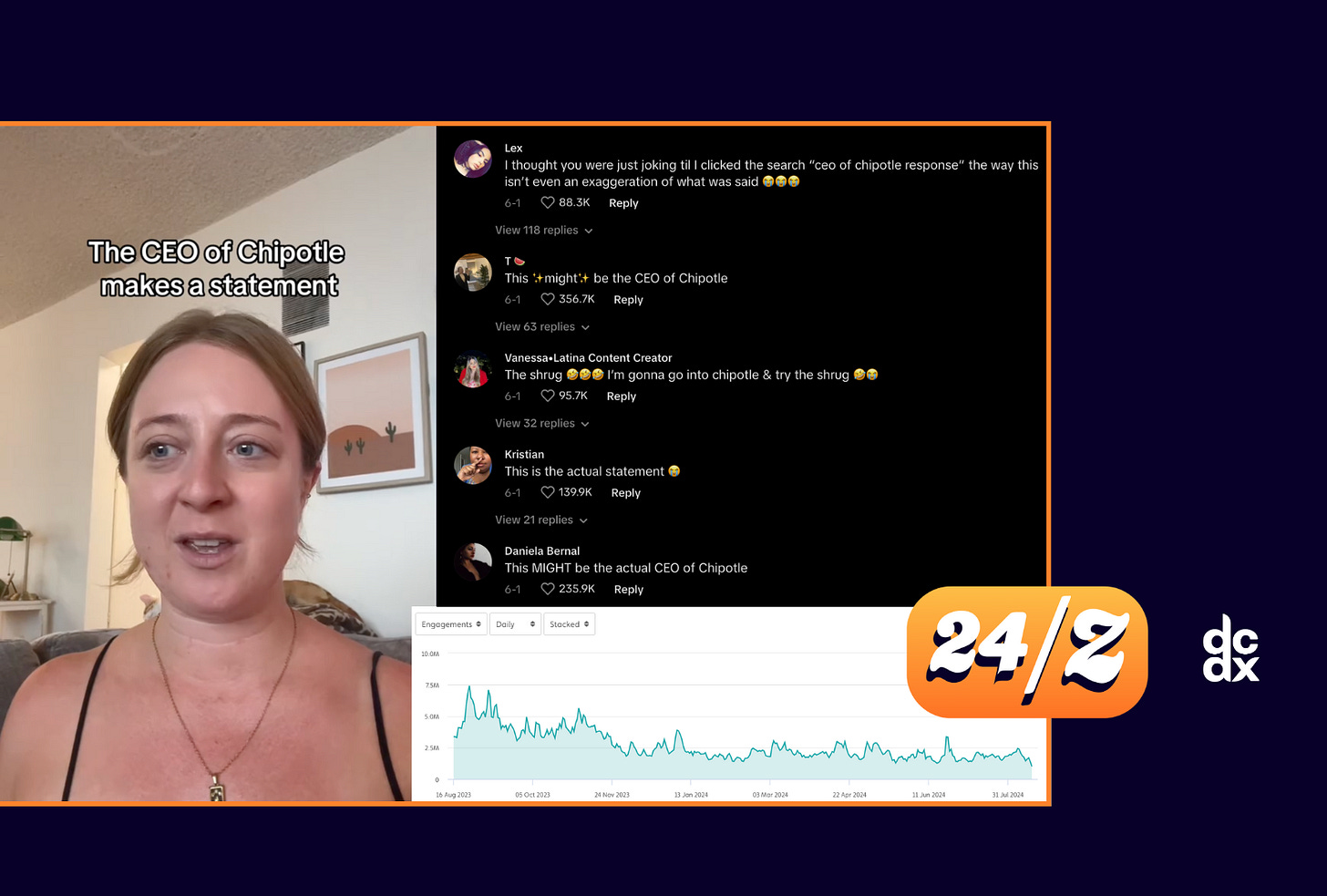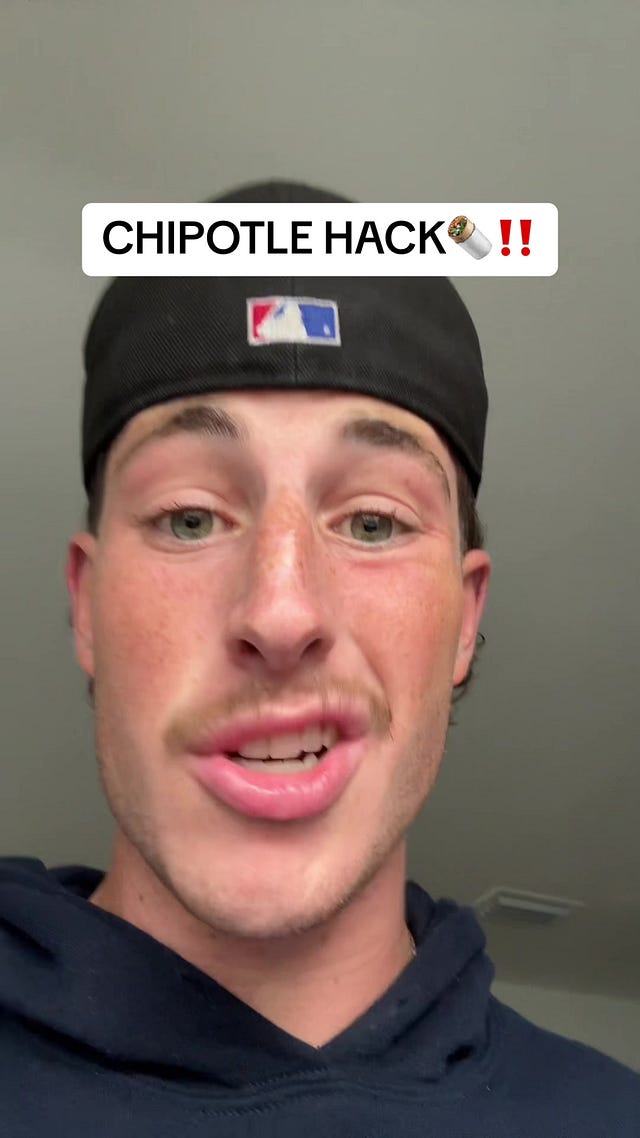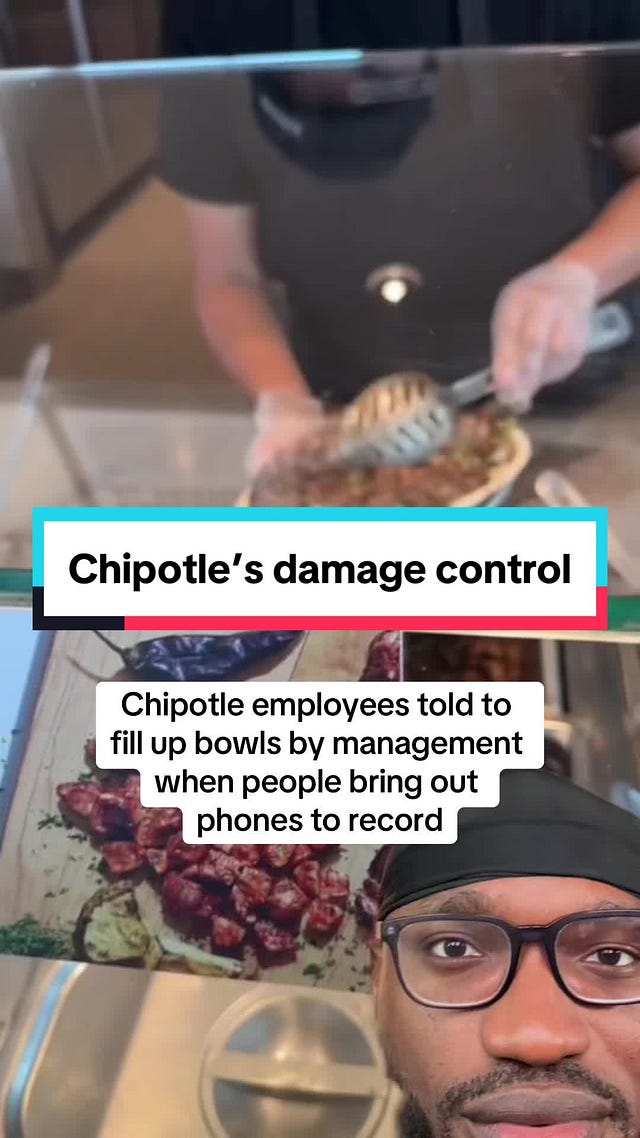Is all UGC good UGC?
What Starbucks can learn from Chipotle's negativity, and all user-generated content is good user-generated content
Chipotle has long been one of Gen Z’s Most Magnetic Brands, placing 22nd in the Top 25 Most Magnetic Brands of 2023. And yet they trailed Starbucks, placing 7th in the 2023 rankings, and yet a brand in 2024 struggling to keep pace with the category.
Three days ago, Starbucks announced the hiring of Chipotle’s CEO Brian Niccol to help the brand return to its dominance. Both brands have been under fire in the comment sections, from Chipotle’s portion struggles to Starbucks’ boycotting.
Niccol’s price tag is massive - but perhaps he knows a secret that others may not.
🎢 Chipotle’s Bumpy 2024 Journey
March 2024: Portion Hacking Goes Viral
A video popped up on seemingly everyone’s FYP about turning a burrito bowl into the world’s best Chipotle burrito. Yano, a regular guy doing this forever, turned this casual content into a viral sensation.
His approach inspired countless copycats, and even Chipotle noticed, forming a partnership and actively interacting with his posts. “The method” - as the user starts to refer to it - became a sensation. Today, the original video has 16.9 Million views and 1.8 million likes on TikTok.
 Tiktok failed to load.
Tiktok failed to load.Enable 3rd party cookies or use another browser
May to June 2024: Keith Lee’s Chipotle Review…and its ripple effects
The prominent and popular TikTok food critic Keith Lee - who partnered with Chipotle in the past - posted a new review of the restaurant in the late spring that set TikTok ablaze. He said matter-of-factly, “something changed, and I don’t know what it is.” A restaurant where he previously rated the food a 10/10 got a new blistering score of 2.5 out of 10. The comments agreed with Lee, calling out that the portion sizes have been subpar.
What followed the Keith Lee review was not just an influx of speculation around whether or not the claims around portion size had merit; regular people started flocking into Chipotle locations themselves to see if the claims were true.
As a consequence, some people took matters into their own hands by recording employees as a “hack” to get bigger portion sizes. Some even claimed that employees were instructed to be generous with their portion sizes if a customer pulled out a phone.
 Tiktok failed to load.
Tiktok failed to load.Enable 3rd party cookies or use another browser
Portion size complaints, “evidence,” and conspiracies were swirling so quickly, that Chipotle’s own TikTok account even chimed in - making fun of the fact that people were pulling out their phones in the restaurant.
When the then CEO Brian Niccol said that customers can just give a subtle, non-verbal head nod to get an extra scoop - the internet saw right through it. It drew a parody from a popular TikTok comedian that now has amassed 22.5 million views and 2.8 million likes, and is now one of the most-watched, most engaged-with organic videos about Chipotle ever.
 Tiktok failed to load.
Tiktok failed to load.Enable 3rd party cookies or use another browser
With the dust settling around all the portion-hacking and portion-complaining, what effect did all of this have on Chipotle?
Chipotle moves up in the rankings 🔺
Chipotle has long been a Gen Z favorite, placing 22nd in our Top 25 Most Magnetic Brands of 2023. The official GenZ Score® for the brand in 2023 was 87.8, and our most recent score placed them at 91.3.
Engagement with Chipotle-related organic content shows a steady upward trend - and a huge bump this year. This late spring/summer, daily engagements on user-generated content (UGC) were 2x that of the previous highest peak in late 2022/early 2023.
Despite the online negativity, Chipotle is still surging with Gen Z
While it may not look like it from the comment sections, Chipotle is performing stronger than ever. Their ‘24 Q2 earnings revealed that total revenue increased 18.2% to $3.0 billion, with comparable restaurant sales increasing 11.1%. In short, more and more people were walking into Chipotle’s doors, and they were also ordering more each time.
Two weeks ago we outlined in The Shareholder Value of User-Generated Content that when brands cause organic conversation online, it directly translates to shareholder gains. What happened this summer to Chipotle might seem negative in the comments, but in reality, their sales surged.
Starbucks’ declining online presence 🔻
Starbucks, on the other hand, shows a different type of story. Starbucks’ conversation online has slowly and consistently decreased over the past year, from ~1.5B monthly views to ~<1B monthly views on UGC. Engagements in the last year have dropped as well, from ~7 million daily engagements in August 2023 to ~2.5 million daily engagements steadily in Summer 2024.
Starbucks Q2 ‘24 earnings reported Net Revenues down 2% and comparable same-store sales down 4%.
This reveals a new truth: in the modern landscape of hyper-consumption, the worst thing that can happen to a brand is not negative content or conversation.
The death of a brand today is caused by the absence of any conversation at all.
How do brands increase UGC?
If brand growth is directly correlated with and potentially caused by increased UGC, how do brands increase UGC?
We analyze brands through this lens of Brand Magnetism® to understand not only how much conversation surrounds them online, but how frequent that conversation is, and most importantly what themes drive that conversation. Each of these is an output; the result of actions by a brand, performed over time, that lead to their Magnetism in culture.
Recently, we’ve been asking - if these are the outputs, what are the inputs? Our working hypothesis right now centers around four key forces to building a Magnetic Brand in culture in 2024.
People: partners, creators, customers, and celebrities a brand shows up with
Places: IRL experiences and places that bring the brand to life
Product: the products or services a brand offers
Platforms: how brands show up across different channels
We call these Magnetic Spaces: the strategic levers of a brand that cause conversation, traffic, and ultimately drive sales and shareholder value.
We believe when one of these forces fails, the promise of a brand to its audience goes unfulfilled.
Unfortunately, simply pulling on each of these four forces is not a strong enough playbook. They require a lens - a strategic insight - in which to activate against.
And today, in a culture muddied by a constant stream of noise, that lens is often blurry, diffracted, and unclear.
That is, of course, unless you have the right tools to see culture clearly.








